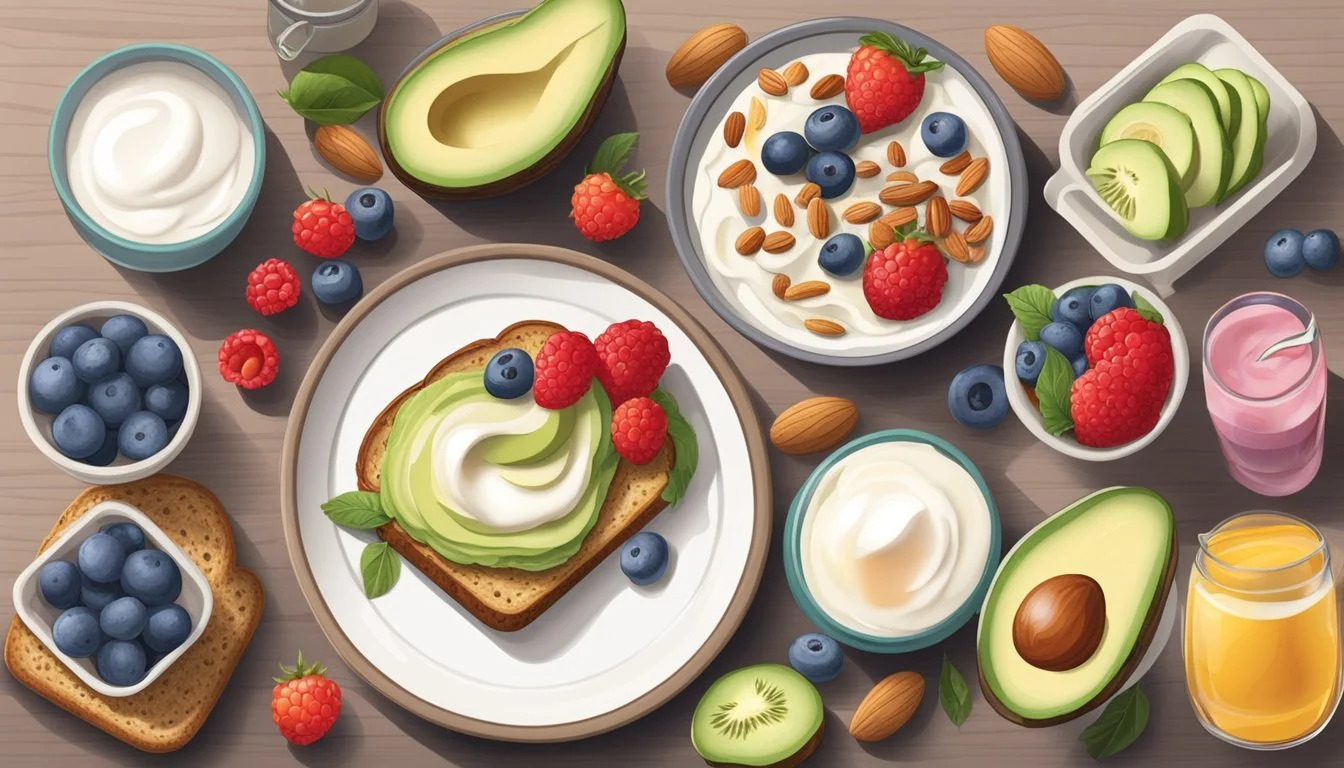Delicious Low-Carb Breakfast Ideas for Diabetics (No Eggs Required)
Living with diabetes doesn't mean sacrificing a delicious and satisfying breakfast. While eggs are a popular low-carb option, there are plenty of egg-free alternatives that can help manage blood sugar levels effectively. Diabetes-friendly breakfasts without eggs can include whole grains, lean proteins, and fiber-rich foods that provide sustainable energy throughout the morning.
For those looking to diversify their morning meals, options like tofu scrambles, Greek yogurt parfaits, and chia seed puddings offer protein-packed alternatives. These choices not only cater to different tastes but also provide essential nutrients to support overall health and diabetes management.
Incorporating a variety of foods in breakfast can help individuals with diabetes maintain stable blood glucose levels while enjoying flavorful meals. From savory options like avocado toast with smoked salmon to sweet treats like berry smoothie bowls, the possibilities for egg-free, diabetes-friendly breakfasts are both nutritious and exciting.
Understanding the Importance of a Balanced Diabetic Breakfast
A balanced diabetic breakfast sets the foundation for stable blood sugar throughout the day. It provides essential nutrients and energy while supporting overall health and well-being for individuals managing diabetes.
Role of Breakfast in Blood Sugar Regulation
Eating breakfast helps regulate blood sugar levels after the overnight fasting period. It jumpstarts metabolism and provides the body with necessary fuel for the day ahead. A well-balanced morning meal can prevent sudden spikes in blood glucose and maintain more consistent levels.
For people with diabetes, skipping breakfast may lead to increased hunger later, potentially resulting in overeating at subsequent meals. This can cause difficulty in managing blood sugar levels throughout the day.
A balanced diabetic breakfast typically contains 30-45 grams of carbohydrates. Pairing carbs with protein and healthy fats further stabilizes blood sugar and promotes satiety.
Macronutrients and Dietary Fiber
A diabetic-friendly breakfast should include a mix of macronutrients: protein, complex carbohydrates, and healthy fats. Protein sources like Greek yogurt or plant-based alternatives help maintain muscle mass and provide lasting fullness.
Complex carbohydrates such as whole grains, quinoa, or oatmeal offer sustained energy release. These foods are rich in fiber, which slows digestion and helps control blood sugar levels.
Healthy fats from sources like avocados or nuts contribute to meal satisfaction and aid in nutrient absorption. Dietary fiber plays a crucial role in blood sugar management and digestive health.
Incorporating fiber-rich fruits and vegetables adds vitamins, minerals, and antioxidants without significantly impacting blood sugar. Berries, apples with skin, and non-starchy vegetables like spinach are excellent choices.
Identifying Hidden Sugars and Carbohydrates
Being aware of hidden sugars and carbohydrates in breakfast foods is crucial for effective diabetes management. Many popular breakfast items contain added sugars that can cause rapid blood glucose spikes.
Reading nutrition labels carefully helps identify sources of hidden sugars. Look for terms like glucose, fructose, or corn syrup in ingredient lists. Opt for unsweetened versions of products when available.
Some seemingly healthy options may be high in carbohydrates. For example, fruit juices can contain as much sugar as soda. Choose whole fruits instead, which provide fiber along with natural sugars.
Portion control is key when including carbohydrates in a diabetic breakfast. Use measuring tools or visual guides to ensure appropriate serving sizes. This practice helps maintain stable blood sugar levels throughout the morning.
Egg-Free Breakfast Ideas for Diabetes
Diabetic-friendly breakfasts without eggs can be delicious and nutritious. These options provide balanced nutrients while helping manage blood sugar levels.
High-Protein Options
Greek yogurt parfaits offer a protein-packed start to the day. Layer plain Greek yogurt with fresh berries and a sprinkle of nuts for added crunch. This combination provides protein, fiber, and healthy fats.
Chia seed pudding is another protein-rich choice. Mix chia seeds with non-dairy milk and let it sit overnight. Top with sliced almonds and a small portion of fruit for a satisfying meal.
Protein smoothies blend well with busy mornings. Combine protein powder, spinach, and a small amount of frozen fruit with unsweetened almond milk for a quick, nutritious breakfast.
Whole Grain Selections
Oatmeal remains a classic choice for diabetics. Choose steel-cut or rolled oats and cook with water or non-dairy milk. Add cinnamon, a handful of nuts, and a small amount of berries for flavor.
Whole grain toast topped with mashed avocado provides healthy fats and fiber. Sprinkle with seeds like pumpkin or sunflower for extra nutrients and texture.
Quinoa breakfast bowls offer a unique twist on traditional hot cereal. Cook quinoa in advance and reheat with a splash of milk. Top with nuts, seeds, and a drizzle of sugar-free syrup.
Low-Carb Breakfast Recipes
Vegetable frittatas sans eggs can be made using chickpea flour. Mix with water, nutritional yeast, and seasonings. Pour into a pan with sautéed vegetables for a savory breakfast.
Cauliflower hash browns serve as a low-carb alternative to potato-based versions. Grate cauliflower, mix with almond flour and spices, then pan-fry until crispy.
Breakfast salads offer a refreshing morning option. Combine mixed greens, cherry tomatoes, and cucumber. Top with grilled tofu or tempeh for protein. Dress lightly with olive oil and lemon juice.
Recipes and Preparations
Diabetic-friendly breakfasts without eggs offer diverse options that are both delicious and nutritious. These recipes focus on whole grains, lean proteins, and fiber-rich ingredients to help manage blood sugar levels effectively.
Smoothies and Smoothie Bowls
Smoothies provide a quick and easy breakfast option for diabetics. Blend unsweetened almond milk with berries, spinach, and a scoop of protein powder for a nutrient-packed drink. Add chia seeds for extra fiber and omega-3 fatty acids.
For smoothie bowls, use a thicker consistency and top with sliced almonds, fresh berries, and a sprinkle of cinnamon. This combination offers a satisfying mix of textures and flavors while keeping carbohydrates in check.
Try a green smoothie with kale, cucumber, and avocado for a low-sugar option rich in healthy fats and vitamins.
Oatmeal and Overnight Oats
Oatmeal is an excellent choice for diabetics due to its high fiber content and low glycemic index. Prepare steel-cut oats with unsweetened almond milk and top with fresh berries and a dollop of almond butter.
Overnight oats offer a convenient make-ahead option. Mix rolled oats with chia seeds, unsweetened Greek yogurt, and a small amount of honey. Refrigerate overnight and top with sliced bananas and crushed walnuts in the morning.
For added protein, stir in a scoop of unflavored protein powder or a tablespoon of hemp seeds.
Creative Toasts and Toppings
Whole grain or sprouted bread toasts provide a fiber-rich base for various toppings. Spread mashed avocado on toast and top with sliced tomatoes and a sprinkle of sea salt for a savory option.
For a sweet variation, try almond butter topped with thinly sliced apples and a dusting of cinnamon. This combination offers healthy fats and protein to help stabilize blood sugar levels.
Another option is to spread low-fat cottage cheese on toast and top with sliced strawberries and a drizzle of sugar-free maple syrup.
Healthy Pancakes and Waffles
Diabetic-friendly pancakes and waffles can be made using almond flour or whole wheat flour. Mix the flour with baking powder, unsweetened almond milk, and a small amount of stevia for sweetness.
Add mashed bananas or grated zucchini to the batter for extra moisture and nutrients. Cook the pancakes or waffles and top with fresh berries and a dollop of Greek yogurt.
For a protein boost, blend cottage cheese into the batter. This addition helps create a fluffy texture while increasing the protein content of the meal.
Incorporating Superfoods into Your Breakfast
Superfoods can transform a diabetes-friendly breakfast into a nutrient powerhouse. These foods offer exceptional health benefits while helping manage blood sugar levels effectively.
Benefits of Berries and Nuts
Berries pack a powerful punch of antioxidants and fiber. Blueberries, strawberries, and raspberries are low in carbohydrates and high in vitamins.
Adding a handful of berries to yogurt or oatmeal can enhance flavor without spiking blood sugar. Berries also contain compounds that may improve insulin sensitivity.
Nuts like almonds and walnuts provide healthy fats, protein, and fiber. They help slow digestion and promote satiety, making them ideal for diabetes management.
A small serving of mixed nuts can add crunch and nutrition to breakfast bowls or smoothies. Nuts also offer magnesium, which plays a role in glucose metabolism.
Using Seeds like Chia and Flaxseed
Chia seeds and flaxseeds are rich in omega-3 fatty acids and fiber. They can significantly improve the nutritional profile of breakfast dishes.
Chia seeds absorb liquid and form a gel-like consistency, making them perfect for puddings or as a topping for smoothie bowls. They help stabilize blood sugar levels.
Flaxseeds can be ground and added to baked goods or sprinkled on top of yogurt. Both seeds provide lignans, which may help reduce diabetes risk.
Incorporating these seeds into breakfast routines can increase feelings of fullness and provide essential nutrients for overall health.
Avocado for Healthy Fats
Avocados are a versatile superfood rich in monounsaturated fats and fiber. They can be a valuable addition to a diabetes-friendly breakfast.
Mashed avocado on whole-grain toast provides a satisfying combination of healthy fats and complex carbohydrates. This pairing helps maintain stable blood sugar levels.
Avocados also contain potassium, which supports heart health - an important consideration for those with diabetes. Their creamy texture makes them an excellent addition to smoothies.
Adding sliced avocado to breakfast salads or omelets can increase nutrient density and promote feelings of fullness throughout the morning.
Considerations for a Low-Carb Breakfast
A low-carb breakfast can help manage blood sugar levels and provide sustained energy throughout the morning. Careful food selection, portion control, and understanding carbohydrate impacts are key factors to consider.
Understanding Carbs and Their Effects
Carbohydrates have the most significant impact on blood sugar levels. Simple carbs like sugars are quickly absorbed, causing rapid spikes. Complex carbs take longer to digest, resulting in a more gradual rise.
Fiber, a type of carbohydrate, slows digestion and helps stabilize blood sugar. It's found in vegetables, nuts, and seeds.
Net carbs, calculated by subtracting fiber from total carbs, give a more accurate picture of blood sugar impact. Focus on foods with lower net carbs for better glucose control.
Identifying Low-Glycemic Foods
The glycemic index (GI) measures how quickly foods raise blood sugar. Low-GI foods are preferable for a diabetes-friendly breakfast.
Examples of low-GI breakfast options:
Greek yogurt with berries
Avocado on low-carb bread
Chia seed pudding
Smoothie with unsweetened almond milk and spinach
These choices provide nutrients without causing significant blood sugar spikes. Pairing low-GI foods with protein or healthy fats further slows digestion and improves satiety.
Portion Control and Meal Planning
Controlling portion sizes is crucial for managing carbohydrate intake. Use measuring tools or visual guides to ensure appropriate serving sizes.
A balanced low-carb breakfast might include:
1/4 plate non-starchy vegetables
1/4 plate protein
1/4 plate complex carbs
1 tbsp healthy fats
Plan meals in advance to ensure variety and nutrient balance. Prep ingredients ahead of time for quick, easy breakfast assembly.
Consider spreading carbohydrate intake throughout the day rather than consuming a large amount at once. This approach can help maintain steady blood sugar levels.
Dietary Tips for Long-term Diabetes Health
Maintaining a balanced diet is crucial for managing diabetes and promoting overall health. Key strategies include focusing on heart-healthy choices, adapting traditional meals, and exploring vegan and gluten-free options.
Heart-Healthy Choices
Reducing saturated fat intake is essential for heart health in people with diabetes. Choose lean proteins like skinless chicken, fish, and plant-based options such as tofu or legumes.
Incorporate omega-3 rich foods like salmon, walnuts, and flaxseeds into meals. These can help improve insulin sensitivity and reduce inflammation.
Use healthy oils like olive or avocado oil for cooking. Replace butter with avocado or nut butter spreads on whole grain toast.
Add fiber-rich foods to breakfast, such as oatmeal topped with berries and chia seeds. This combination supports heart health and helps manage blood sugar levels.
Adapting Traditional Meals for Diabetes
Transform favorite breakfast dishes into diabetes-friendly versions. Swap regular pancakes for whole grain or almond flour alternatives topped with fresh fruit instead of syrup.
Replace sugary cereals with homemade granola using nuts, seeds, and a small amount of honey. Pair with unsweetened plant-based milk for a nutritious start to the day.
Create a savory breakfast bowl using quinoa, roasted vegetables, and a small portion of lean protein. This balanced meal provides sustained energy without spiking blood sugar.
Modify smoothies by using Greek yogurt, spinach, and berries. Add a scoop of protein powder to increase satiety and stabilize blood glucose levels.
Vegan and Gluten-Free Alternatives
Plant-based breakfast options can be both vegan and gluten-free while supporting diabetes management. Try overnight oats made with gluten-free oats, chia seeds, and unsweetened almond milk.
Prepare a tofu scramble with vegetables as an egg-free alternative. Season with turmeric and black pepper for added flavor and potential anti-inflammatory benefits.
Make a breakfast parfait using coconut yogurt, mixed berries, and gluten-free granola. This combines protein, fiber, and healthy fats to help control blood sugar.
Experiment with sweet potato toast topped with mashed avocado and hemp seeds. This provides complex carbohydrates, healthy fats, and plant-based protein in one meal.
Supplements and Add-Ins for Enhanced Nutrition
Protein smoothies offer a convenient way to boost nutrition in diabetic breakfast options. Adding a scoop of protein powder can increase satiety and help manage blood sugar levels.
Healthy fats like chia seeds, flaxseeds, or avocado can be incorporated into meals to provide essential omega-3 fatty acids and promote better nutrient absorption.
Fiber supplements such as psyllium husk or inulin can be mixed into beverages or sprinkled over food to aid digestion and slow glucose absorption.
A multivitamin supplement may be beneficial to fill any nutritional gaps. Key vitamins and minerals for diabetics include vitamin D, magnesium, and chromium.
Consider adding ground cinnamon to breakfast dishes. This spice has been shown to have potential blood sugar-lowering effects.
Unsweetened cocoa powder can be mixed into smoothies or yogurt for a chocolatey flavor without added sugars. It also provides antioxidants and minerals.
Greek yogurt serves as an excellent protein-rich base for breakfast bowls. It can be topped with nuts, seeds, and berries for added nutrition and flavor.
Incorporating these supplements and add-ins can enhance the nutritional value of diabetic breakfasts while maintaining balanced blood sugar levels.
Practical Advice for Busy Mornings
Managing diabetes doesn't have to be time-consuming. With smart planning and preparation, you can enjoy nutritious breakfasts that fit your schedule and health needs.
Quick and Easy Meal Prep
Prepare protein pancakes in advance and freeze them for quick reheating. Mix dry ingredients for quick oats in individual containers, adding hot water when ready to eat. Create low-carb granola batches to last the week.
Store pre-portioned smoothie ingredients in freezer bags. In the morning, blend with your choice of liquid for an instant meal.
Cook a large batch of turkey bacon on weekends. Reheat a few slices each morning for a protein boost.
Convenient On-the-Go Options
Pack portable breakfast items the night before. Hard-boiled eggs, Greek yogurt cups, and cheese sticks offer protein without preparation.
Grab a handful of nuts and seeds for healthy fats and protein. Pair with a small piece of fruit for balanced nutrition.
Keep individually wrapped protein bars in your bag for emergencies. Choose low-sugar options with at least 10 grams of protein.
Making Smart Choices When Eating Out
Look for menu items with lean proteins and vegetables. Opt for egg white omelets or vegetable frittatas.
Ask for whole grain toast instead of white bread. Request dressings and sauces on the side to control portions.
Choose unsweetened beverages like coffee, tea, or water. Avoid fruit juices and sweetened drinks that can spike blood sugar.
Consider ordering from the à la carte menu to create a balanced plate. Combine a protein source with a small serving of complex carbohydrates.
Monitoring and Adjusting Your Breakfast Routine
Tracking blood sugar responses, adjusting quantities and ingredients, and personalizing your breakfast routine are key steps for managing diabetes effectively. These strategies help optimize your morning meal for better glucose control.
Tracking Blood Sugar Responses
Regularly monitoring blood glucose levels before and after breakfast provides valuable insights into how different foods affect your body. Use a glucose meter to check your levels upon waking and 2 hours after eating.
Keep a food diary alongside your glucose readings. Note the specific foods, portion sizes, and any physical activity.
This data helps identify patterns and trends in your blood sugar responses to various breakfast options. Look for meals that keep your glucose within target ranges set by your healthcare provider.
Adjusting Quantities and Ingredients
Based on your blood sugar tracking, make informed adjustments to your breakfast choices. Modify portion sizes to find the right balance for your metabolism and glucose control.
Experiment with ingredient swaps. Replace high-glycemic foods with lower-glycemic alternatives. For example, switch refined grains for whole grains or add more fiber-rich vegetables.
Pay attention to protein and healthy fat content. These nutrients can help slow glucose absorption and promote satiety. Adjust the ratios of carbohydrates, proteins, and fats to find your optimal mix.
Feedback and Personalization
Your body's responses to food can change over time. Regularly review your blood sugar data and meal logs to spot any shifts in your glucose patterns.
Consult with a registered dietitian or diabetes educator for personalized advice. They can help interpret your data and suggest tailored adjustments to your breakfast routine.
Consider factors like medication timing, stress levels, and sleep quality when analyzing your results. These variables can impact blood sugar and may require tweaks to your morning meal plan.
Be patient and persistent. Finding the right breakfast routine for your diabetes management is an ongoing process of trial and adjustment.








